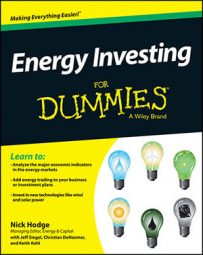As an energy investor, before knowing where the world’s oil reserves are, you must first understand different types of reserve estimates and realize that they change constantly. The main categories of reserves you commonly see used are:
Proven (P90, 1P)
Proven developed (PD)
Proven undeveloped (PUD)
Unproven
Probable (P50, 2P)
Possible (P10, 3P)
The Society of Petroleum Engineers (SPE) provides the most widely accepted definitions of these terms. You need to understand the definitions of these reserve types because they’re an important factor in how to evaluate oil-producing countries and companies. In fact, the Securities and Exchange Commission (SEC) requires companies to disclose how much oil they have access to based on these definitions.
A demand shift
As of early 2013, six of the top ten oil-producing countries are also on the top ten list of oil-consuming countries. Their consumption rate is growing much faster than production growth, especially in Saudi Arabia and Brazil. When these countries had smaller populations and economies, they didn't need as much oil.
Now that they’re growing, they need more of their oil for themselves. And that means less oil available for the global market — and for importers like the United States and China. This is a long-term trend that will keep upward pressure on oil prices.
Proven reserves
Proven reserves are those thought to have at least 90 percent certainty of being developed given the current economic conditions and technology at the time of evaluation. Oil prices, cost of production, and type and depth of the deposit are all factored in to the level of certainty. Industry insiders refer to proven reserves as P90 or 1P.
Proven reserves are further divided into two subcategories: proven developed (PD) and proven undeveloped (PUD). Proven developed reserves can be produced in and around existing oil fields and wells with little new investment. Proven undeveloped means additional capital investment is required to extract the oil.
The most recent data from the EIA estimates total world proven oil reserves at 1.3 trillion barrels. This table shows the countries with the largest proven oil reserves as of 2010.
| Country | Proven Reserves (Billions of Barrels) |
|---|---|
| Saudi Arabia | 262.4 |
| Venezuela | 211.2 |
| Canada | 175.2 |
| Iran | 137 |
| Iraq | 115 |
| Kuwait | 104 |
| United Arab Emirates | 97.8 |
| Russia | 60 |
| Libya | 46.4 |
| Nigeria | 37.2 |
The countries in the table account for around 90 percent of total world oil reserves. But simply having the most reserves doesn’t automatically make a country a top producer. Venezuela, for example, has the second most oil reserves but isn’t a top-ten producer.
Lack of sustained investment, the perils of dictatorship, and the relationships that stem from geopolitics play a major role in a country’s ability to effectively bring its reserves to market. This couldn’t be more apparent than in the United States, which, even though it isn’t a reserve powerhouse, is still the world’s number three producer because of friendly investment and regulatory policies and its technological prowess.
Unproven reserves
Unproven reserves are evaluated using the same geologic and engineering techniques as proven reserves, but technological, economic, or political factors preclude them from having a 90 percent certainty of production. Unproven reserves are classified as either probable or possible, with probable reserves having about 50 percent certainty of recovery, and possible reserves having at least 10 percent certainty of production.
In the industry, probable reserves are referred to as P50 or 2P, and possible reserves are referred to as P10 or 3P.
Getting accurate data
Evaluating these changing factors is a big part of making successful investment decisions. Various organizations and government entities evaluate them in different ways. And companies and countries have numerous reasons for misstating or being deliberately vague about their reserves, including company valuations and production quotas.
Russia, for example, to be perceived as more of a powerhouse, has routinely reported reserves of more than 190 billion barrels, while credible reporting agencies peg its reserves closer to 60 billion.
To stay up to date on ever-changing global reserve numbers, make sure to check out the most recent reports at the following websites:

